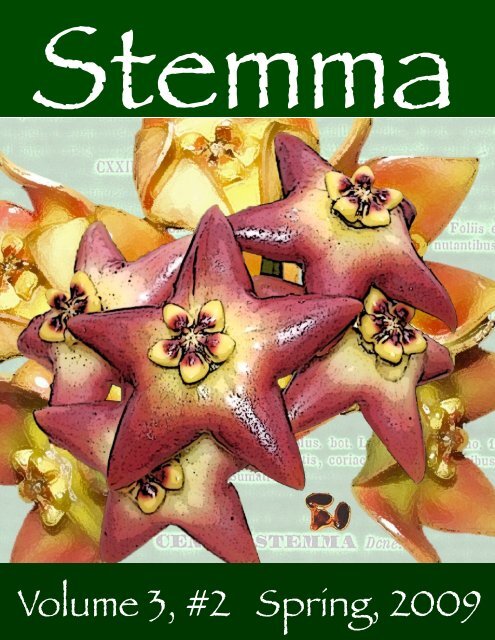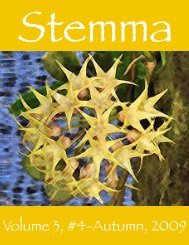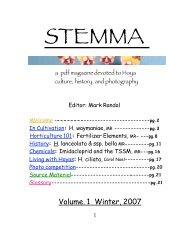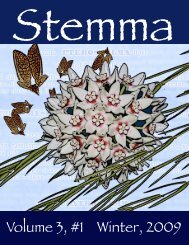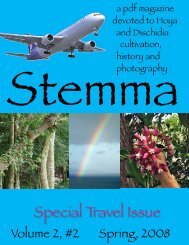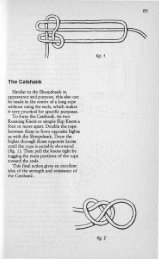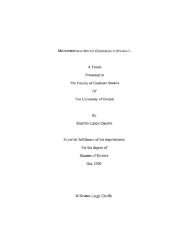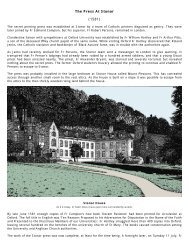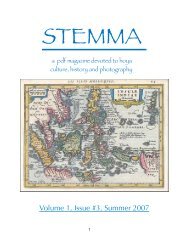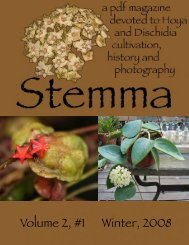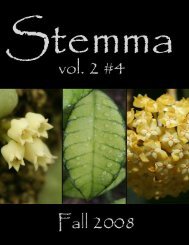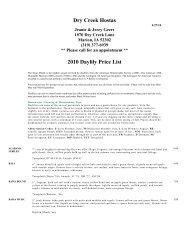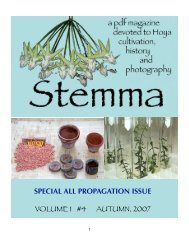Volume 3, Issue #2 - Cubits
Volume 3, Issue #2 - Cubits
Volume 3, Issue #2 - Cubits
Create successful ePaper yourself
Turn your PDF publications into a flip-book with our unique Google optimized e-Paper software.
Stemma<br />
<strong>Volume</strong> 3, <strong>#2</strong> Spring, 2009<br />
1
3 Editor's Note<br />
contents<br />
4 Talking with the experts by Antone Jones<br />
12 A look at Hoya sections- part 4 by Mark Randal<br />
29 Reprint: Hoya manipurensis Deb (as Micholitzia obcordata N.E. Br.)<br />
31 Source Materials<br />
32 Appendix A MR<br />
33 Back Page: Hoya sp. AH-240 MR<br />
Editor: Mark Randal<br />
Editor of Dischidia Content: Antone Jones<br />
Technical Consultant: Bobby Fisher<br />
Stemma Godmother: Carol Noel<br />
Availability: Downloads of this and past issues are available at the Stemma website:<br />
www.stemmajournal.com<br />
The official Stemma forum is online at:<br />
www.http://tech.groups.yahoo.com/group/thestemmaforum<br />
Posting Stemma for download on unauthorized sites is prohibited.<br />
Usage Policy: Stemma may be distributed freely as a whole by private individuals, but<br />
content and photos remain the intellectual property of the individual contributor and may<br />
not be reproduced separately. Use of any portion of Stemma (including photographic<br />
content) for commercial gain is strictly prohibited.<br />
© Stemma Magazine 2009<br />
2
Editor’s Note<br />
The Stemma website has evolved a wide and<br />
growing collection of photographs of species and cultivars of Hoya and Eriostemma. Click on<br />
the Hoya or Eriostemma gallery at our homepage:<br />
http://www.stemmajournal.com<br />
It is hoped that in time this will become a comprehensive resource for research and plant<br />
identification. I invite you to check in from time to time to see our progress and view the images,<br />
contributed by many Hoya aficionados and researchers from around the world. Please feel free<br />
to send in photographs of species or cultivars we have not added yet, or alternate photographs of<br />
covered species. Send any contributions to the editor at:<br />
markroy68@yahoo.com<br />
The Stemma forum also has grown, and features taxonomic discussions, images of blooming<br />
plants, cultivation discussions, and images of new species recently brought into cultivation or<br />
growing in the wild:<br />
http://tech.groups.yahoo.com/group/thestemmaforum/<br />
This issue concludes a four part article on subdivisions (sections or species complexes) within<br />
the genus Hoya. With our next issue, Stemma will shift focus slightly to present more material<br />
on Hoya, Dischidia and Eriostemma cultivation. A series of articles from various growers, highlighting<br />
some of their favorite species, will begin in that issue.<br />
I would here like to thank a number of people for their input or contributions to the Hoya sections<br />
article.<br />
Torill Nyhuus and Jeanette Karlsen, editors of Hoyatelegrafen, the bulletin of the Swedish<br />
Hoya Society, have generously allowed Stemma the use of photographs from the SHS website<br />
(http://www.swedishhoyasociety.com/eng/hoya.htm) and from their personal collections.<br />
Dale Kloppenburg provided input on the initial entry for this series in which the morphological<br />
features of Hoya species were described. Mr. Kloppenburg also generously allowed the free use<br />
of many of his microphotographs of Hoya pollinaria.<br />
Michele Rodda provided criticism of my handling of the taxonomy and nomenclature of the<br />
various sections and complexes described here.<br />
Surisa Somadee provided many photographs of her own and facilitated the use of some from<br />
her Thai language forum: http://www.thailandhoyaclub.com. n<br />
3
Talking with the experts<br />
By Antone Jones<br />
Living in central Florida has its perks. This part of the state has a large concentration<br />
of nurseries, many of which grow Hoya and Dischidia. None, however, grow them quite<br />
like one nursery in particular: Hermann Engelmann Greenhouses. Most will know this<br />
company by their trademark, “Exotic Angel” plants. I had the wonderful opportunity to<br />
speak to one of Hermann Engelmann’s location managers about their fantastic Hoya and<br />
Dischidia.<br />
What’s your name and what do you do here?<br />
“My name is Jayson Opgenorth and I am the head grower for Hermann Engelmann<br />
Greenhouses in Apopka, Florida, and am also in charge of general quality control<br />
for the company. I graduated from Texas A&M University with a B.S. in Horticulture<br />
in 1992.”<br />
How long have you worked for Hermann Engelmann Greenhouses?<br />
“16 years.”<br />
How many different Hoya and Dischidia does the company grow?<br />
“Approximately 18 Hoyas and around 7 Dischidia.”<br />
4
How long has the company been growing Hoyas? How about Dischidia?<br />
“Hoyas since the beginning, 36 years ago and Dischidias began about 5 years ago.”<br />
What was the first Hoya that the company grew and released to the public?<br />
“36 years ago we began to grow Hoya carnosa compacta (Hindu rope) , Hoya carnosa<br />
compacta ‘Regalis’, Hoya carnosa compacta ‘Mauna Loa’, Hoya carnosa ‘Krimson<br />
Princess’ (Rubra) and Hoya carnosa ‘Krimson Queen’ (tricolor). I would not say we<br />
released them as many came from the breeder Cobia, and since the patents have run<br />
out, we simply use Rubra, Tricolor, Rope and other names. The first Hoya we actually<br />
“released” to the public is Hoya lacunosa ‘Snow caps’ which we know is a made<br />
up name and not recognized by any authority, but that is what we call it.”<br />
Hoya compacta ‘Regalis’<br />
5
There has been a lot<br />
of buzz over Hoya lacunosa<br />
“Snow Caps.”<br />
Where did that plant<br />
originate?<br />
“This is a beautiful<br />
plant. We simply<br />
found one vine out of<br />
thousands that had a<br />
chlorophyll-deficient<br />
chimera. We selected<br />
it, continued to grow<br />
and reselected until<br />
it was stable. This is<br />
a nice addition to<br />
our Hoya mix.”<br />
Hoya lacunosa ‘Snow Caps’<br />
What are some species that you’ve tried that didn’t work out in the long run? What about<br />
them didn’t work out?<br />
“Hoya multiflora is the first one that comes to mind. It simply grew too big too fast<br />
and did not have the right growth structure for a hanging basket in our opinion. We<br />
also tried Hoya carnosa ‘Marlea’ and found it to be too unstable.”<br />
6
Of the Exotic Angel Hoya and Dischidia that you grow, which is your personal favorite<br />
and why?<br />
“Hoya linearis simply due to the challenge of growing a perfect specimen. It is a real<br />
accomplishment to bring these to marketable size, and to my knowledge no other<br />
commercial greenhouse produces it large scale. Dischidia nummularia ‘Pebble<br />
beach’ is my favorite Dischidia that we grow. It has such unique color and shaped<br />
foliage and is a very versatile plant. It can be mounted or grown in soil. Our 8.0<br />
hanging basket provides a little too much soil for this species, so you must be careful<br />
with over watering.”<br />
Hoya linearis Stock Plants<br />
7
Hoya linearis<br />
8
Dischidia nummularia ‘Pebble Beach’<br />
9
Often times we hear that people have watering issues with some Exotic Angel hanging<br />
baskets. Usually they find that these plants rot. What’s shocking is that here in the facility,<br />
these plants look fantastic and they are started here from cuttings to finished plant. Do<br />
you have any ideas as to why people are having these experiences?<br />
“This is probably due to our soil being engineered to withstand the shipping process<br />
and also to hold up at retail level. We are currently working on a new mix that will<br />
provide more pore space, yet maintain acceptable water holding capacity. This new<br />
soil has proven to provide our plants with an exceptional advantage and provide<br />
proper delivery of water, nutrients and oxygen to the rhizosphere. We will begin to<br />
use the new soil this Spring and although it may appear similar, the components and<br />
chemistry have been retooled.”<br />
Where can we find these various Exotic Angel swinging baskets other than Home Depot<br />
and Lowes?<br />
“Our plants are also available in Walmart, Target, Kroger and Publix grocery<br />
stores, and various other retail stores. You can also check www.exoticangel.com/shop<br />
for our online store highlighting various products that change all the time.”<br />
Are there any new releases for 2009? If so, what are they?<br />
“Yes, we have 2 more variants of Hoya lacunosa. One has a deep red or maroon leaf<br />
blade, especially on the newer growth, and a dark almost black stem and petioles.<br />
We have named this one 'Ruby Sue' and it has been released. We will introduce another<br />
variant of Hoya lacunosa that appears as a cross between the above mentioned<br />
maroon 'Ruby Sue' and 'Snow caps'. This one will knock your socks off, deep maroon<br />
leaf blades with the white speckles of 'Snow caps' complimented by black stem<br />
and petioles. We have named this one 'Royal Flush" and should be released it in our<br />
hanging baskets by late summer.”<br />
It was a great experience talking with Jayson about their Exotic Angel plants. I would like<br />
to thank Jayson and the entire Hermann Engelmann Greenhouses company for giving me<br />
some time to sit and speak with them. Seeing their impressive operation and the fantastic<br />
Hoya and Dischidia that they grow was an experience I’ll not soon forget. If you’d like to<br />
know more, please visit, www.exoticangel.com<br />
-Antone n<br />
10
Hoya lacunosa ‘Ruby Sue’<br />
11
A look at<br />
Hoya sections<br />
Part 4<br />
by Mark Randal<br />
This is the fourth and final installment of the Stemma series exploring the groups (designated<br />
as “sections” or, less formally, as “species complexes”) of similar species within the genus<br />
Hoya. The species included in each of these groups share similarities of floral structure, and, to a<br />
lesser degree, vegetative parts. The species in each group also often share cultural preferences.<br />
Therefore a working knowledge of the Hoya sections can be useful to horticulturalists and collectors<br />
in providing a general idea of the physical form, scent, flower type, and cultivation needs<br />
of a given species, if that species can be assigned a place in the devised system of species complexes<br />
discussed in this four part article.<br />
Previous sections discussed in this series show numerous possible links to other sections, suggesting<br />
that there are broad lines of genetic divergence within Hoya that have resulted in similar<br />
groups which share some common morphological features. In this portion of the sections article<br />
five groups of like species are presented. Three of these groups are distinguished from the groups<br />
discussed previously in that they are very different from the vast majority of species grouped into<br />
the genus Hoya. They do not have morphological features which show obvious links to any<br />
other group discussed here, so that these groups suggest a widely divergent genetic line from the<br />
bulk of Hoya species.<br />
These three groups are sections Centrostemma and Antiostelma, and genus Eriostemma. Eriostemma<br />
was previously included within the genus Hoya as a section, and was listed in the first<br />
portion of this article as such. Eriostemma was elevated to genus rank by D. Kloppenburg & E.<br />
Gilding in 2001, but the publication has been widely criticized and deemed invalid by some<br />
sources. A closer look by this author found that the flaws indicated by some of these sources do<br />
not invalidate the publication of Eriostemma, nor are there any other obvious problems which<br />
would render this publication invalid. Due to its closely shared history with Hoya, Eriostemma is<br />
still presented here, though recognized as a separate genus.<br />
One section, Cystidianthus, is presented in this section of the article not because it shows no<br />
morphological links to the other sections already presented, but because it shows so many possible<br />
links to many other groups it would seem unwise to speculate about its possible affinities<br />
until further molecular testing is performed on the species associated with this taxon.<br />
One section, Kloiphora, was originally included here as it seemed to display no overt affinity<br />
with other Hoya sections, but recent research by this author, with input from Antone Jones, suggests<br />
a probable linkage of this group to section Otostemma. This speculation is corroborated by<br />
findings in the molecular studies conducted by Livia Wanntorp (2006a, 2006b). Therefore, section<br />
Kloiphora should have been included next to section Otostemma, in part one of this article.<br />
12
22: Section Cystidianthus (Hassk.) King & Gamble<br />
Etymology: “cystis” = “bladder”, Gr. + “anthos” = “flower”, Gr.<br />
Type species: Hoya campanulata Blume.<br />
Overall form: species grouped here can display a bushy, upright habit when young, but even young<br />
plants will also twine readily. Leaves are thin textured, medium to large, oval with a sharply pointed tip.<br />
Flowers are large, cup-shaped, cream or nearly white, and intensely fragrant.<br />
Distribution: Java, Sumatra, Malaysia.<br />
Publication: (as a genus) Hasskarl, J. K. 1843. Hoev. & De Vriese’s Tijdschrift voor Natuurlijke Geschiedenis<br />
en Physiologie 10: 125; (as a section) King, G. 1910 “Flora of the Malayan Peninsula”. Journal of<br />
the Royal Asiatic Society, Bengal Branch 74 (2): 559--563<br />
Original description: (translated from Latin by Dale Kloppenburg)“Calyx pentamerous. Corolla somewhat<br />
campanulate, shallowly 5 lobed, at first the lobes spreading, later reflexed. Corona of 5 segments,<br />
fused to the short gynostegium; corona segments fleshy, spreading, flattened with the lower margins inrolled,<br />
the exterior angle rising upward, interior produced into a tooth lying upon the anther. With the<br />
terminal membrane of the anther appressed to the stigma. Pollinia attached at the base, erect, oblong,<br />
flattened, here with an almost transparent margin. Stigma convex 5-sided blunt. With the seed pod solitary<br />
through abortion, elongate, cylindrical, smooth. Seeds harry-tufted. Shrubs of the Indian Archipelago<br />
with the general appearance of a Centrostemma.<br />
Revised descriptions: King, G. “in Flora of the Malayan Peninsula”- “Corolla rotate-campanulate; lobes<br />
very short, broader than long; corona processes with lower lobes spreading, upper erect.”<br />
Salient features:<br />
Pollinarium- pollinia are roughly three times as long as wide, and the ratio in size of the pollinia to the<br />
corpuscula are very similar to the those of the pollinaria of section Hoya and Hoya pottsii complex species.<br />
The caudicles, however, are quite large and broad, unlike those found in section Hoya or the H.<br />
pottsii complex, as are the translators, as is found in sections Acanthostemma and Otostemma. Both the<br />
caudicles and translators are attached low on the corpusculum side and quite long in comparison to<br />
those of most Hoya species.<br />
Corona- the corona segments are roughly horizontal on their upper surface, with the anther appendages<br />
exceeding the height of the corona lobe. Segments appear long-ovate from above, and have a furrow<br />
which runs the longitudinal length of each segment.<br />
Corolla- narrowly or flattened campanulate.<br />
Raceme- loosely convex.<br />
Species thought to belong in this section/complex:<br />
Hoya campanulata Blume (type) * Hoya wallichii (Wight) C. M. Burton* Hoya cystiantha Schltr. **<br />
Hoya phyllura O. Schwartz<br />
* It is disputed whether one or two species are represented by the determinations now prevalent for H.<br />
wallichii and H. campanulata.<br />
** The name Hoya cystiantha may not be technically valid.<br />
13
Taxonomic considerations: The first grouping possibly incorporating a member of this group was R.<br />
Wight’s genus Physostelma (1834), which had as its type species Hoya wallichii. The publication of<br />
Wight’s Physostelma precedes the publication of Hasskarl’s genus Cystidianthus by nine years, and since<br />
both publications are thought by many botanists to deal with morphologically similar species (or possibly<br />
the same species, if H. wallichii is synonymous with H. campanulata, as some sources suggest<br />
[Kloppenburg, 1994]), genus Physostelma has precedence and would be considered the legitimate name<br />
for this grouping. However, Schlechter’s transfer of genus Physostelma into genus Hoya (1914) is rendered<br />
invalid by Art. 53.4 of the ICBN (International Code of Botanical Nomenclature), which states:<br />
“the names of two subdivisions of the same genus, or of two infraspecific taxa within the same species,<br />
even if they are of different rank, are treated as homonyms, the later of which is illegitimate, if they have<br />
the same or a confusingly similar final epithet and are not based on the same type.”<br />
Clearly, the name Physostelma is not able to be transfered into the genus Hoya as a section due to the<br />
previous publication of a section Physostemma Blume (1849), which has Hoya coriacea Blume as its type.<br />
The two names, Physostemma and Physostelma, are more than just similar, they are slightly different<br />
variations of the same greek words “physo” (bladder-like) and “stemma” or “stelma” (crown). The code<br />
prevents duplicate names of this sort in order to prevent the confusion of the taxa involved. Since the<br />
ICBN prevents the transfer of genus Physostelma into genus Hoya as a section, the newer name Cystidianthus<br />
would be the applicable name for this section, unless efforts were undertaken to conserve the<br />
name Physostelma, which would result in the valid inclusion in the infrageneric structure of Hoya the<br />
confusingly similar names Physostelma and Physostemma.<br />
There is a considerable amount of debate over the number of, and proper names for, the species which<br />
seem to belong in section Cystidianthus. Differing sources have the names H. campanulata and H. wallichii<br />
as synonyms or as distinct species, and some botanists believe that the true Hoya wallichii is a very<br />
different plant from the one presented here as H. wallichii so different that it would not belong grouped<br />
with the other campanulate species placed into Cystidianthus with H. campanulata. The plant sold most<br />
commonly as “Hoya cystiantha” is thought to have an invalid name by some sources, and H. phyllura<br />
has not been widely inspected for a consensus to emerge concerning its determination, due largely to its<br />
apparently very demanding cultivation requirements.<br />
Several botanists are working to clarify the standing of this group of species, so changes in species<br />
names or determinations are probable.<br />
14
15<br />
Section Cystidianthus.<br />
1) Hoya cystiantha (L) and<br />
Hoya wallichii (R) (photo<br />
courtesy of Ted Green and<br />
Green: Plant Research.<br />
2) Hoya wallichii (photo courtesy<br />
of Carol Noel).<br />
3) Hoya campanulata (photo<br />
courtesy of David Liddle).<br />
4) Hoya cystiantha (photo<br />
courtesy of David Liddle.<br />
5) Hoya phyllura (photo courtesy<br />
of David Liddle).<br />
6) Pollinarium of Hoya wallichii<br />
(photomicrograph courtesy<br />
of Dale Kloppenburg).<br />
7) Pollinarium of Hoya cystiantha<br />
(photo courtesy of Torill<br />
Nyhuus).<br />
8) Hoya phyllura (photo courtesy<br />
of David Liddle).<br />
9) Hoya campanulata (photo<br />
courtesy of David Liddle).<br />
10) Hoya wallichii (photo<br />
courtesy of Carol Noel).
23: Section Kloiphora King & Gamble<br />
Etymology: “chlamyd” (uncertain- no more probable root was found) = “cloak”+ “phorum” = “carrying”,<br />
Gr.<br />
Type species: Hoya curtisii King & Gamble.<br />
Overall form: Hoya curtisii is a small leaved epiphytic vine which climbs through use of adventitious<br />
roots and rarely or never twines. Leaves are about 1.5cm, rounded with a sharp tip, quite hard-textured.<br />
Flowers are medium sized, reflexed, pale greenish-white to yellow, and fragrant. Hoya waymaniae,<br />
which also may belong here, has medium sized leaves, also very hard, a scrambling, non-twining habit,<br />
and flat clusters of bright orange, ball-shaped flowers.<br />
Distribution: Thailand, Malaysia, the Philippines.<br />
Publication: King, G. 1910. “Flora of the Malayan Peninsula”. Journal of the Royal Asiatic Society,<br />
Bengal Branch 74 (2): 559--563<br />
Original description: “Corona-processes with lower lobe globose, hollow, laterally compressed; upper<br />
shorter-curved; corolla-tube with a broad annular ring (corolline corona?)”.<br />
Revised descriptions: none.<br />
Salient features:<br />
Pollinarium- pollinia are elongate and club shaped, translators are fairly broad, not so pronounced as<br />
the translators of those species grouped in or around sections Acanthostemma or Otostemma. The corpuscula<br />
are relatively small and narrow compared to the pollinia.<br />
Corona- lobes appear approximately round from above, segments are tall, middle portions are excised,<br />
lower surfaces curve up and end in a point midway up the segment.<br />
Corolla- reflexed to revolute.<br />
Raceme- flat or loosely convex.<br />
Species thought to belong in this section/complex:<br />
Hoya curtisii King & Gamble (type) Hoya waymaniae D. Kloppenburg(?)<br />
Taxonomic considerations: Kloiphora has no apparent taxonomic problems associated with its publication<br />
or standing.<br />
Since the inception of this article, and thanks to the input of Antone Jones regarding similarities between<br />
the two species tentatively included in Kloiphora in this article and Hoya endauensis Kiew, a closer<br />
look was taken at these species by this author.<br />
Hoya endauensis, which was included in section Otostemma in part one of this article, does indeed<br />
share a very similar corolla structure with Hoya waymaniae, and while the corona of H. endauensis<br />
bears a close affinity to those coronas of section Otostemma species, with their characteristic coronal<br />
skirts, the pollinarium of H. endauensis shares features of both section Otostemma and section Kloiphora<br />
species pollinaria (the basic shape of Otostemma pollinia, the narrowness and relatively small<br />
size of the corpuscula of section Kloiphora species pollinaria). In looking closer at the Wanntorp (2006a,<br />
2006b) studies, which conducted molecular testing on a small sample of Hoya species, it appears that<br />
this author over-looked those studies’ results placing H. lacunosa Blume (in section Otostemma) and H.<br />
curtisii in the same clade, which suggests a close genetic relationship. In light of this, and considering<br />
the possibility that H. endauensis may represent a transitional species between these two sections, it appears<br />
that section Kloiphora should probably have been included near to section Otostemma in this article,<br />
rather than discussed in this portion of the article, which addresses complexes which are apparently<br />
more widely divergent genetic groups from the main body of Hoya species.<br />
16
Section Kloiphora. 1) Hoya curtisii. 2) Hoya curtisii (photo courtesy of Bob Ely).<br />
3) Hoya waymaniae. 4) Hoya waymaniae, side of corona segment. 5) Hoya waymaniae,<br />
corona. 6) pollinarium of Hoya waymaniae. 7) Pollinarium of Hoya curtisii (microphotograph<br />
courtesy of Dale Kloppenburg). 8) Hoya waymaniae. 9) Hoya curtisii (photo courtesy<br />
of Bob Ely).<br />
17
24: Section Centrostemma (Decne.) Bentham & Hook. f.<br />
Etymology: “centron” = “a sharp point”, Gr. + “stemma” = “crown”, Gr.<br />
Type species: Hoya multiflora Blume<br />
Overall form: these species are bushy, non-twining, mostly terrestrial plants with conspicuous large clusters of<br />
white, pointed, reflexed flowers sometimes tinged with pink, yellow or green. Flowers are mostly not strongly fragrant.<br />
Even small plants in this taxon seem to flower readily.<br />
Distribution: Thailand, Malaysia, western Indonesia.<br />
Publication: (as a genus) Decaisne, A. 1838. Annales des Sciences Naturelles; Botanique 9 (2): 271; (as<br />
a section) Bentham, G. & Hooker. J. D. 1876. Genera Plantarum 2: 776--777<br />
Original description: (as a genus) (translated from Latin by Dale Kloppenburg) “Calyx pentamerous. Corolla<br />
deeply divided into 5 reflexed lobes, with a prominent beard about the base of the gynostegium. Corona of 5<br />
stamens, attached at the upper part of the elongated gynostegium; corona segments fleshy, upright, depressed<br />
above, with the lower margins inrolled, at the base prolonged into a spreading or horn-like spur, at the apex<br />
narrowed into a tooth longer than the stigma. With the terminal membrane of the anther oppressed to the<br />
stigma. Pollinia affixed at the base, erect, oblong, compressed, here with a sub transparent margin. Stigma<br />
apiculate. Follicles single, elongate, cylindrical, smooth. Seed hairy-tufted. ---The climbing plant growing in<br />
the Indian Archipelago, the Moluccas and the Philippines with leaves opposite, leathery, somewhat veined,<br />
glabrous; with the many flowered umbels pedunculate between the petioles and terminal. With flowers often<br />
rather large, yellowish.”<br />
Revised descriptions: Bentham & Hooker. f. (1876), (as a section) (translated [poorly] from Latin by MR)<br />
“Corolla lobes narrow, staminal tube usually longer and interior angle of corona scale long, produced; these<br />
characters notwithstanding these (few or one) species are by no means a separate genus. Species from Silhet,<br />
corolla lobe equally narrow and scale-like, inside long produced...”<br />
Salient features:<br />
Pollinarium- the pollinia are proportionally longer and narrower than those of the vast majority of Hoya<br />
species. The translators are narrow. The corpuscula are relatively very narrow and small.<br />
Corona- the inner corona lobe apex is raised high above the anther membranes, the outer apex is lowered.<br />
The base of the corona is modified into a tall staminal column. This structure is also found in genus Eriostemma,<br />
but in that genus the column is proportionally much broader than in Centrostemma species.<br />
Corolla- lobes are sharply reflexed, margins are revolute.<br />
Raceme- loosely convex.<br />
Species thought to belong in this section/complex:<br />
Hoya multiflora Blume (type) Hoya javanica Boerl. H. sp. Cyrtoceras floribundum Maund<br />
Taxonomic considerations: The names Centrostemma and Cyrtoceras were published as genera in the same<br />
year, 1838. The publication of the name Centrostemma preceded that of the name Cyrtoceras by several months<br />
(Kloppenburg, 1994), so the name Centrostemma has priority.<br />
Genus Cyrtoceras was absorbed into genus Hoya by Bentham & Hooker f. (1876), with Centrostemma as a synonym.<br />
The name Centrostemma has priority, so it is not clear at this time whether this publication would serve to<br />
validly publish the name Centrostemma. If not, the 1994 work “Hoya Sections” by D. Kloppenburg should serve<br />
to validly re-rank the name Centrostemma. In the latter case, the citation would be changed to Centrostemma<br />
(Decne.) D. Kloppenburg.<br />
This taxon seems to be composed of several species, but more work is needed to define the boundaries of<br />
these taxa.<br />
18
Section Centrostemma. 1) Hoya sp. Cyrtoceras floribundum (photo courtesy of<br />
Gabi Rothman). 2) Hoya javanica (photo courtesy of David liddle). 3) Pollinarium of Hoya<br />
sp. Cyrtoceras floribundum (photo courtesy of Dale Kloppenburg). 4) Pollinarium of Hoya<br />
aff. javanica. 5) Hoya aff. javanica. 6) Hoya sp. Cyrtoceras floribundum. 7) Hoya multiflora<br />
(photo courtesy of David Liddle).<br />
19
25: section Antiostelma Tsiang & P. T. Li<br />
Etymology: “antio”= “opposite” L. (?) + “stelma” = “crown”, Gr.<br />
Type species: Hoya manipurensis Deb<br />
Overall form: H. manipurensis is a scrambling, non-twining epiphyte with small, heart-shaped, succulent<br />
leaves and small, tube-shaped, greenish-white flowers. H. telosmoides, also possibly belonging<br />
grouped into this section, is a twining epiphyte with small, urn-shaped white flowers with elongated,<br />
spreading corolla tips.<br />
Distribution: southern China, eastern India, Burma, Thailand (all H. manipurensis) & Borneo (H. telosmoides).<br />
Publication: (see Taxonomic considerations, below) (as a section) Acta Phytotax. Sin. 12(1): 126. 1974.<br />
Original description: (translated from Latin by Mark Randal) “similar to section Pterostelma (Wight), corolla<br />
cylindic, lobes erect twisting to the left, staminal corona erect margins recurved, pollinia almost<br />
subquadrate-ovate with a well distinguished pellucid margin at the base.”<br />
Revised descriptions: none.<br />
Salient features:<br />
Pollinarium- pollina are rounded, slightly longer than wide, translators are narrow, corpuscula are relatively<br />
small.<br />
Corona- segments are laterally compressed, inner lobe is acute and erect, elevated high above the outer<br />
corona lobe apex. The anther apex is elongated and greatly exceeds the height of the inner corona lobe<br />
apex.<br />
Corolla- urceolate, densely pubescent on the inner surfaces.<br />
Raceme- loosely convex.<br />
Species thought to belong in this section/complex:<br />
Hoya manipurensis Deb (type) Hoya telosmoides R. Omlor (?)<br />
Taxonomic considerations: This taxon was originally recognized as genus Micholitzia N. E. Brown<br />
(1909). This taxon was also published as Hoya section Antiostelma Tsiang & P. T. Li (1974) and as genus Antiostelma<br />
(Tsiang & P. T. Li) P. T. Li (1992). These later two publications were produced on the assumption that<br />
this group was an un-described genus, missing the earlier publication of Micholitzia. The two genus<br />
names were later reconciled under Micholitzia N. E. Brown by P. T. Li et al. (1994) (see the Reprint section<br />
on page 29 of this issue of Stemma).<br />
This taxon was taken back into the genus Hoya by Livia Wanntorp et al. (2007a) as a single species,<br />
under the name Hoya yuennanensis Hand.-Mazz. This name later proved to be unsupportable, and the<br />
name was then recognized as Hoya manipurensis Deb (Wanntorp, 2007b).<br />
Hoya telosmoides also shares several key features of corona and pollinaria morphology with Hoya manipurensis,<br />
and so may belong grouped into section Antiostelma.<br />
The name Antiostelma as a section may prove to be an invalid name, as Tsiang & Li’s publication of section<br />
and genus were later found to be synonymous with genus Micholitzia. The name Micholitzia, therefore,<br />
may be a more suitable name for this section.<br />
20
Section Antiostelma. 1) Hoya telosmoides (photo courtesy of Torill Nyhuus & the Swedish<br />
Hoya Society). 2) Corona of Hoya telosmoides (photo courtesy of Torill Nyhuus & the Swedish<br />
Hoya Society. 3) Corona of Hoya manipurensis & 5) details of the illustration of the pollinarium<br />
(lower left) and leaves and flowers (right) of Hoya manipurensis, as presented on pgs. 29-30<br />
of this issue). 4) Pollinarium of Hoya telosmoides (photo courtesy of Dale kloppenburg).<br />
21
26: genus Eriostemma (Schltr.) D. Kloppenburg & Gilding<br />
Etymology: “Erio” = “wooly”, Gr. + “stemma” = “crown”, Gr.<br />
Type species: Eriostemma coronaria (Blume) D. Kloppenburg & Gilding.<br />
Overall form: these species are rampant, twining lianas which have a terrestrial, rarely or never epiphytic,<br />
habit. Leaves are medium-sized, ovate-acute, pinnately veined, with no silver splotching. Except<br />
for the interior of the corollas and the upper coronas of these species, mostly all parts of the foliage and<br />
flowers are covered with dense to scattered hair. Flowers are large to giant-sized, thick, mostly rotate but<br />
occasionally reflexed (E. ciliata) or shallowly cup-shaped (E. lauterbachii), usually not strongly fragrant,<br />
ranging in color from white and pale green through pink and orange to dark brownish-red.<br />
Distribution: tropical Australia, New Guinea, Indonesia, Malaysia, Thailand, the Philippines.<br />
Publication: (as a section) Schlechter, 1914. “Die Asclepiadaceen von Deutsch-Neu-Guinea”.<br />
Botanische Jahrbücher für Systematik, Pflanzengeschichte und Pflanzengeographie 50 (sup.): 81--164;<br />
(as a genus) D. Kloppenburg & Gilding. Fraterna 14(2). 2001.<br />
Original description: (translated from German by Dieter Paul & Dale Kloppenburg) “...the stems and<br />
leaves with all surfaces (parts) covered with short soft hairs; in other respects its blooms possess marked,<br />
sharp characteristics..... The gynostegium stands upon a column which goes down into the crown of the<br />
collar of the corolla which is covered with shaggy cottony hairs. The corona scales are comparatively<br />
short. The blooms are large or very large with a well developed, thickly hirsute calyx. Type species of<br />
the section is H. coronaria Blume.”<br />
Also, from the same publication: “I thought it best to present here this distinctive section Eriostemma.<br />
This section is so well and sharply different, that one could consider whether or not to regard it as a<br />
separate sub-genus. I have so far presented above briefly the main points, but now I wish to present<br />
them once again in more detail. In habit there is a strong similarity that can be found with EU-Hoya, but<br />
the branches are softer and more fleshy and consistently with more or less soft hairs. The peduncles are<br />
extraordinarily thick and soft textured, the calyx as with Pterostelma more strongly structured, and the<br />
large hairy blooms are likewise fleshy. The gynostegium with the corona scales stand upon a woolly matted<br />
column that is the outgrowth formed of the filaments, which are united with the corona tube. The<br />
pollinia are distinguished (marked) as opposed to the other Hoya species by means of the fact that the<br />
translators have undergone a strong development and exhibit a twist; also the retinaculum is rather large.<br />
The pollinia are more club shaped and moreover do not have the keel on the outer edge, characteristic<br />
of other Hoya sections.”<br />
22
Revised descriptions: Kloppenburg (2001): “This section is so distinctive and has so many sharp differences<br />
from other hoyas that it has been proposed to make it into a subgenus of Hoya (Schlechter) or<br />
even a distinct genus in its own right (Dr. Ken Hill). With this in mind the diagnostic features are as follows:<br />
1. Stems and leaves with soft short hairs<br />
2. Gynostegium stands on a column<br />
3. Column covered with shaggy cotton-like hairs<br />
4. Corolla with distinct collar<br />
5. Large flowers<br />
6. Thick hirsute calyx<br />
7. Branches soft and fleshy<br />
8. Peduncles extraordinarily thick and soft<br />
9. Flowers hairy and fleshy<br />
10. Pollinia club shaped with no pellucid border<br />
11. Translator arms long, twisted<br />
12. Retinaculum large”<br />
Kloppenbug & Gilding (2001): (as a genus) “Stems slightly fleshy, 3-10mm thick. All parts exude milky<br />
sap when injured. Leaves and stems covered with pubescence except in a few species, in which case the<br />
plant possesses a notable covering of indumentums on young growth but becomes glabrous when mature.<br />
Stems and the upper leaf surface are of the same color. No noticeable red pigment in young vegetative<br />
shoots. Stems twining or prostrate, supple when young, later becoming lenticelate and finally with<br />
corky bark. Petiole always developed but short, 1-5cm in length, round in cross section or nearly so<br />
without a channel on the upper surface. Leaves fleshy, 2-5mm thick, succulent, opposite in whorls.<br />
Leaves faintly glanduliferus on upper leaf surface where it is attached to the petiole. Leaf shape obovate,<br />
oblong, or elliptic, but always apiculate at the apex with recurved margins. Nerves always pinnate,<br />
sometimes not visible in fresh state. Inflorescence consists of a short peduncle that is of the same thickness<br />
and texture of the stem, the end developed into an extremely compressed panicle. Peduncles are<br />
either persistent, flowering numerous times or deciduous and flowering only once. Flowers are produced<br />
in clusters from the end of the peduncle in numbers from one to twenty but with a mean of six.<br />
Pedicels range from 2-15cm in length, thick and supple occasionally pubescent. Calyx of five large lobes<br />
usually spatulate, adnate to corolla. Corolla always valuate, thick and rigid. Inside of corolla is cetaseous,<br />
being glabrous to densely villose. Lobes of the corolla short to elongate. Corolla lobe posture variable<br />
between species from recurved to flat or incurved. Tube short or non-existent, when present it is patellae<br />
to cupulate. Base of corolla beneath corona is unique, abruptly cupulate and adnate with column<br />
of corona, sericeous in all species. The corona column is also sheathed with corolla tissue that is densely<br />
sericeous in all species. Color of corolla ranges from white to green-yellow or orange to deep dull redbrown.<br />
The structure forms a deep inverted annulus from which nectar is produced. Corona lobes simple<br />
inornate, inner (central) lobe acute and laterally flattened. Outer lobe broad also inornate erect to flat<br />
but always broadly obtuse. Usually yellow or yellow with red areas, rarely all white. Pollinaria have<br />
rhomboidal retinaculum, with the unique character of twisted translator arms, pollinia always flask- like<br />
in shape without obvious pellucid edge frequently found in Hoya Br. Follicles large, elongate to 35cm<br />
and thick in cross-section to 5cm. Outside pubescent or glaucous, mamillate at apex. Unique character<br />
of well developed spongiform mesocarp. Seed number 250 to 450 per follicle, freshly ochre-white in<br />
color but becoming dull green-blue with age, comate.”<br />
23
Salient features:<br />
Pollinarium- the pollinia are club shaped, approximately twice as long as wide, and lack a pellucid edge.<br />
Translators and caudicles are twisted strongly. Corpuscula are relatively large, square.<br />
Corona- segments are usually relatively flat, acute at interior angle, rounded at exterior angle, with a median<br />
furrow on the upper surface. Underside of segments are broadly channeled. Overall the coronas of the species<br />
placed in genus Eriostemma are very similar morphologically to those of species grouped into Hoya section<br />
Amblyostemma, although these taxa are very different in most other respects. The lower portion of the<br />
corona is modified into a tall, broad staminal column which is buried in the corolla tissue.<br />
Corolla- waxy, thick textured. Usually rotate, occasionally reflexed (E. ciliata) to cup shaped (E. lauterbachii).<br />
Raceme- loosely convex.<br />
Species names currently thought to belong in this genus, validly transfered from genus Hoya:<br />
Eriostemma coronaria (Blume) D. Kloppenburg<br />
& Gilding (type)<br />
E. ciliata (Elmer ex. C. M. Burton) D. Kloppenburg<br />
& Gilding<br />
E. affinis (Hemsl.) D. Kloppenburg & Gilding<br />
E. lutea (Kostel.) D. Kloppenburg & Gilding E. madulidii (D. Kloppenburg) D. Kloppenburg<br />
& Gilding<br />
E. ariadna (Decne.) D. Kloppenburg & Gilding<br />
E. gigas (Schltr.) D. Kloppenburg & Gilding E. hollrungii (Warb.) D. Kloppenburg& Gilding*<br />
E. neoguineensis (Engl.) D. Kloppenburg &<br />
Gilding<br />
E. peekelii (Markgr.) D. Kloppenburg & Gilding E. purpurea (Blume) D. Kloppenburg & Gilding E. sussuela (Merr.) D. Kloppenburg& Gilding<br />
E. velutina (Wight) D. Kloppenburg & Gilding*<br />
* see appendix A, pg. 33<br />
Species names thought to belong to this genus, not technically transfered from genus Hoya:<br />
Hoya lauterbachii K. Schum. Hoya pulgarensis Elmer (Nom. Inv.) Hoya guppyi Oliver<br />
Taxonomic considerations: the species grouped here are widely recognized as constituting a distinct morphological<br />
group similar in many ways to the mass of species grouped within the genus Hoya. Opinions vary<br />
on whether this group should be included within genus Hoya as a section or recognized as a distinct, but<br />
closely related genus, as is genus Dischidia.<br />
While these species seem superficially similar to many species accepted in genus Hoya, there are several<br />
features which occur among Eriostemma species which rarely, if ever, occur among Hoya species. Of primary<br />
difference are the pollinaria of the species placed in genus Eriostemma, which have unique, twisted<br />
translators and caudicles and club shaped pollinia lacking a pellucid edge. The presence of a pellucid edge<br />
(a transparent zone on the outer margin of the pollinia through which pollen germination occurs) is a feature<br />
common to all accepted Hoya species, though rudimentary in some species (H. darwinii). The pollinaria of<br />
Eriostemma species also seems to have evolved a slightly different method of attaching themselves to the legs<br />
or probosces of visiting pollinators, a feature that further distinguishes these species from all known Hoya<br />
species (see pg. 28, this issue).<br />
Some other features which distinguish genus Eriostemma species are sometimes found in species accepted<br />
in genus Hoya, and so are not sufficient alone as distinguishing traits to demarcate genus Eriostemma. These<br />
features do provide corroborating evidence to the distinctness of this group of species. Among these “secondary”<br />
distinguishing traits are a terrestrial habit, densely wooly vegetative (and to some degree reproductive)<br />
parts, an extremely well developed staminal column hidden from casual viewing by virtue of being buried<br />
within the corolla, and thick, short follicles usually of a bluish-green color at maturity.<br />
24
Until molecular testing sheds more light on this subject and further publishing is done, this group of species<br />
must now be technically recognized as a genus, as section Eriostemma was re-ranked as a genus by D.<br />
Kloppenburg and Gilding in 2001. This publication has been challenged on various technical grounds.<br />
Further investigation by this author shows no valid reason for this publication to be viewed as invalid (see<br />
appendix A, pg. 32, for a technical discussion on the validity of this publication). However, three species<br />
names were not technically published due to errors in citation or basionym validity: E. guppyi, E. lauterbachii,<br />
and E. pulgarensis.<br />
Several taxonomists have recommended ignoring this publication as it conflicts with their personal interpretation<br />
of what might constitute a separate genus from genus Hoya (pers. com.). But technical publication<br />
is an important aspect of taxonomy and nomenclature, and cannot be dismissed so arbitrarily. Technical<br />
problems prevent the recognition of several species within the genus Hoya as they are commonly accepted<br />
(Hoya bella (technical name Hoya lanceolata ssp. bella), Hoya angustifolia (no technically valid<br />
name), Hoya cystiantha (no technically valid name), Hoya nicholsoniae (reduced to synonymy under Hoya<br />
pottsii). As the technical problems with these names are recognized, so must be the genus status of Eriostemma,<br />
unless and until such time as further publication effects a change of status for this genus.<br />
Further complicating the status of this group is the placement of several species included here into synonymy<br />
under Hoya coronaria by van Donkelaar & Kleijn (2001) shortly after the re-ranking of genus Eriostemma.<br />
This synonymization is questioned by current botanists, but seems to be technically valid, despite<br />
recognizing the plants in that publication as Hoya rather than Eriostemma. An earlier work by Forster<br />
& Liddle (1992) placed (as then recognized) Hoya hollrungii and Hoya ariadna under synonymization to<br />
H. sussuela, but the later Kloppenburg & Gilding publication would seem to technically reinstate those<br />
two species names.<br />
Much work is needed, especially including molecular testing, to clarify the standing of this genus and the<br />
number and correct names of the species contained within it. For this article, the most commonly recognized<br />
names for these taxa are recognized for purposes of clarity, although some may prove to be invalid.<br />
Eriostemma species and hybrids (from left): E. ‘Ruthie’, E. ‘Black Star’, E. ‘Optimistic’, E. sp. Apple<br />
Green (discolored from shipping), E. sp. Bada.<br />
25
Genus Eriostemma. 1) A group of Eriostemma flowers. 2) Eriostemma lauterbachii, compared with an<br />
umbel from Hoya pubicalyx (photo courtesy of Carol Noel. 3) Hoya sussuela (photo courtesy of Joni<br />
Kahn). 4) Eriostemma hybrids climb a tree in Hawaii at the home of Carol Noel.<br />
26
Genus Eriostemma, reproductive parts. The base of the corona for all Eriostemma species have<br />
developed into a tall, broad staminal column which is hidden from casual view as the column is surrounded<br />
by the tissue of the corolla. This feature is found, to a much less developed degree, in some<br />
Hoya species (Hoya multiflora, Hoya curtisii). 1 &2) Corona of E. ‘Ruthie’. 3) E. ‘Ruthie’. 4) E. ‘Ruthie’,<br />
with a part of the corolla removed to reveal the buried staminal column of the corona. 5) Corona of E.<br />
ciliata. 6) Corona of E. ‘Optimistic’. 7) Pollinarium of E. ‘Optimistic’, showing the natural position of the<br />
pollinia and the twisted caudicles/translators, taken with a macro lens on a digital camera. 8) Pollinarium<br />
of E. ‘Optimistic’ showing twisted translators/caudicles taken through a 20x lens. 9) Closeup of the<br />
twisted translators/caudicles (of E. ‘Optimistic’) and one pollinium, taken through a 400x lens.<br />
27
The pollinaria of Eriostemma species seem to have<br />
evolved a different mechanism for attaching themselves to<br />
the bodies of visiting pollinators. In Hoya species, the pollinaria<br />
are formed on the corona with their pollina held out<br />
straight, extending towards the center of the corona (figure<br />
4). When the pollinia are pulled from their positions over the<br />
stigma, the pollinia usually spring inwards, crossing each<br />
other and forming a clasp in which a portion of the pollinators<br />
body may be trapped (figures 5 & 6- the red dots indicate<br />
the likely place where a pollinators leg or proboscis<br />
would be trapped.)<br />
In Eriostemma species, the pollinarium hold their pollinia in<br />
a different position, the base of each held far out from the<br />
corpuscula, the pollinia apex angled inwards, almost touching<br />
(figure 1). When Eriostemma species pollinaria are removed<br />
from the stigma, the pollina tend to swing away from<br />
each other, rather than towards each other, as in Hoya, possibly<br />
due to the twisted nature of the translators/caudicles. In<br />
figure 2, the top pollinarium has both pollina sprung into<br />
their secondary position, the lower two have one each of<br />
their pollinia swung to their secondary position. No studies<br />
seem to have been done to determine the actual method of<br />
polliarium transfer for Eriostemma, but it seems logical that<br />
the likely place for attachment to a visiting pollinator for<br />
these species would be in the complexly twisted translators/<br />
caudicles themselves (figure 3, with two red dots highlighting<br />
the likely place of attachment). n<br />
28
Source Material<br />
Bennet, J.J. 1838. Plantae Javanicae Rariores, descriptae iconibusque illustratae 1: 90.<br />
Bentham, G. & Hooker. J. D. 1876. Genera Plantarum 2: 776--777.<br />
Burton, C. M. 1995/96. “A tentative alternative arrangement of Hoya sections”. The Hoyan. 17 (2part<br />
2):10--12. 17 (3 part 2): 14--18. 18 (1 part 2):3--5. 19 (2 part 2):9--11<br />
Decaisne, A. 1838. Annales des Sciences Naturalles; Botanique 9 (2): 271.<br />
Hasskarl, J. K. 1843. In: Hoev. & De Vriese’s Tijdschrift voor Natuurlijke Geschiedenis en<br />
Physiologie 10: 125<br />
Hooker, J. D. 1885. The Flora of British India 4: 52--63.<br />
King, G. “Flora of the Malayan Peninsula”. Journal of the Royal Asiatic Society, Bengal Branch 74 (2):<br />
559--563.<br />
Kloppenburg, D. 1993. Hoya Sections.<br />
Kloppenburg & Gilding. 2001. “Change of Genus”. Fraterna V.14, #1,2.<br />
Schlechter, R. 1914. “Die Asclepiadaceen von Deutsch-Neu-Guinea”. Botanische<br />
Jahrbücher für Systematik, Pflanzengeschichte und Pflanzengeographie 50 (sup.): 81--164<br />
Tsiang & Li, P. T. 1974. Acta Phytotaxonomica Sinica 12: 126.<br />
Wanntorp, L. et al. 2006a. “Wax plants disentangled: A phylogeny of Hoya (Marsdenieae,<br />
Apocynaceae) inferred from nuclear and chloroplast DNA sequences”. Molec. Phylog. Evol.<br />
39: 722--733<br />
Wanntorp, L. et al. 2006b. “Towards a Monophyletic Hoya (Marsdenieae, Apocynaceae): Inferences<br />
from the Chloroplast trnL Region and the rbcL-atpB spacer”. Syst. Bot. 31(3): 586--596<br />
Wanntorp, L. et al. 2007a. “Phylogenetic relationships between Hoya and the monotypic genera Madangia,<br />
Absolmsia, and Micholitzia (Apocynaceae, Marsdeniaea): insights from flower morphology”.<br />
Ann. Missouri Bot. Gard. 94: 36-55.<br />
Wanntorp L. 2007b. “Systematics of Hoya, challenges and rewards”. Asklepios 99: 9-16.<br />
31
Appendix A<br />
Technical discussion of the validity<br />
of the re-ranking of genus<br />
Eriostemma (Schltr.) D. Kloppenburg & Gilding.<br />
by Mark Randal<br />
In looking at this publication only one serious problem which may affect the validity of the publication of genus<br />
Eriostemma is obvious: the individual species transfer data (except for Hoya coronaria) do not explicitly state the<br />
basionym form of each species name. This point was suggested by Christine Burton in P. S. The Hoyan V.4,#4 and<br />
also indicated in Flora Malesiana Bulletin Vol. 13(1) in the following way: “15 new comb, all invalid (Art. 33.3:<br />
basionyms not mentioned, only referred to!; see also Fraterna 14/1 (2001)”.<br />
This point does not actually agree with the rules of the ICBN, and this view is not supported by the IPNI (International<br />
Plant Name Index) which, while not infallible, does research the names listed therein and notes invalid<br />
names/combinations.<br />
The relevant Article (33.4) of the ICBN states:<br />
"On or after 1 January 1953, a new combination, a new generic name with a basionym, or an avowed substitute<br />
(replacement name, nomen novum) based on a previously and validly published name is not validly published<br />
unless its basionym (name-bringing or epithet-bringing synonym) or the replaced synonym (when a new<br />
name is proposed) is clearly indicated and a full and direct reference given to its author and place of valid publication,<br />
with page or plate reference and date (but see Art. 33.5 and 33.7).<br />
On or after 1 January 2007, a new combination, a new generic name with a basionym, or an avowed substitute<br />
is not validly published unless its basionym or replaced synonym is cited. "<br />
The requirement here states that before 2007 a new combination may be published by “clearly indicating” the<br />
basionym, rather than explicitly citing the basionym, so long as the basionym author and place of publication are<br />
correctly cited. This point is illustrated in example 13 for Article 33.4:<br />
"Ex. 13. The new combination Conophytum marginatum subsp. littlewoodii (L. Bolus) S. A. Hammer (Dumpling &<br />
His Wife: New Views Gen. Conophytum: 181. 2002), being made prior to 1 January 2007, was validly published<br />
even though Hammer did not cite the basionym (Conophytum littlewoodii) but only indicated it by citing its bibliographic<br />
reference. "<br />
As this instance parallels the situation for D. Kloppenburg & Gilding’s Eriostemma species transfers almost exactly<br />
(they all correctly cite basionym author and publication, except as noted below), it seems that the code<br />
would recognize the new Eriostemma species as being validly published.<br />
So this point does not preclude valid publication of Eriostemma as a genus.<br />
There are problems which preclude the valid transfer of two Eriostemma species from the genus Hoya:<br />
Eriostemma guppyi (the author citation is incorrect.)<br />
Eriostemma lauterbachii (the bibliographical citation is incorrect.)<br />
Also:<br />
Eriostemma pulgarensis is rendered invalid, since the basionym, Hoya pulgarensis, is itself not a validly published<br />
name.<br />
Two Eriostemma species (treated at the time as Hoya species- H. hollrungii and H. velutina) were placed into<br />
synonymy under Hoya coronaria by Kleijn & van Donkelaar (2001). This does not reflect the view of most botanists<br />
studying this group today; more study and potential republishing are necessary to clarify the standing of these<br />
potential species, but the names E. hollrungii and E. velutina now stand technically as synonyms of E. coronaria.<br />
n<br />
32
Back page<br />
Hoya sp. AH-240<br />
Country of Origin: New Guinea.<br />
Related/Similar Species: Hoya albiflora, Hoya magnifica, Hoya calycina.<br />
Flower Color: white corolla and corona, with a red stain under the corona.<br />
Flower Size: 2.5cm.<br />
Flower Form: flattened campanulate, divided.<br />
Scent: strong, sweet, spicy.<br />
Leaf size: up to 20cm long, 8cm wide.<br />
Collector: unknown.<br />
Water Requirements: requires regular water, do not let dry out completely.<br />
Light Requirements: partial shade.<br />
Cultivation notes: This species is a vigorous, large leaved vine which will require a large<br />
support as it matures. The roots of this species are extremely vigorous also, and will<br />
quickly fill large containers. H. sp. AH-240 seems to not like to dry out completely, and<br />
keeping mature, root-bound plants watered adequately can be a challenge. Flowering<br />
tends to occur in the autumn, in synch with the similar species H. calycina and H. magnifica.<br />
33


